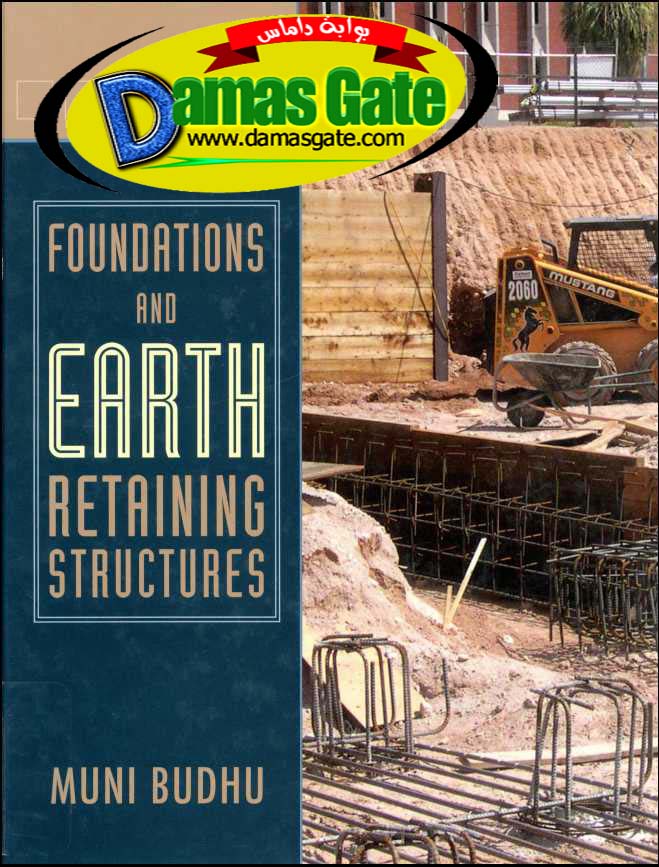Foundations and Earth Retaining Structures by Muni Budhu

Description
Foundations and Earth Structures is written primarily for an undergraduate course in foundation analysis and design. It should also appeal to graduate students and practicing engineers. There are three primary objectives for this textbook. Firstly, to present basic concepts and fundamental principles that are necessary to understand the background of the methods employed in foundation design. Secondly, to inform students on the values and limitations of popular methods of analyses in foundation engineering. Thirdly, to provide a framework for students to carry out simple foundation design and appreciate the design process.
This is a textbook and not a design manual. Consequently, it emphasizes fundamentals rather than procedures. However, practical procedures, where appropriate, are included to allow students to transit into "office" design. The topics are sequenced so as not to rush the students into design but to build a solid foundation in the fundamentals so that they could understand the implications of the assumptions in the design.
Table of Contents
Chapter 1. Review Of Basic Soil Mechanics. Chapter 2. Foundation Loads, Stresses And Strains In Soils.
Chapter 3. Analytical, Numerical Methods And Observational Methods For Foundation Design.
Chapter 4. Settlement, Strength And Deformation Parameters From Laboratory Tests.
Chapter 5. Site Characterization.
Chapter 6. Uncertainties In Foundation Design, Foundation Design Philosophy And Methodologies.
Chapter 7. Design Of Shallow Foundations.
Chapter 8. Pile Foundations.
Chapter 9. Mat Foundations.
Chapter 10. Stability Of Earth Retaining Walls -- Rigid And Flexible Walls.
Chapter 11. Mechanical Stabilized Earth (Mse) Walls And Other Retaining Walls.
Appendix A.
Appendix B.
Appendix C.
312MB
Download
*

Description
Foundations and Earth Structures is written primarily for an undergraduate course in foundation analysis and design. It should also appeal to graduate students and practicing engineers. There are three primary objectives for this textbook. Firstly, to present basic concepts and fundamental principles that are necessary to understand the background of the methods employed in foundation design. Secondly, to inform students on the values and limitations of popular methods of analyses in foundation engineering. Thirdly, to provide a framework for students to carry out simple foundation design and appreciate the design process.
This is a textbook and not a design manual. Consequently, it emphasizes fundamentals rather than procedures. However, practical procedures, where appropriate, are included to allow students to transit into "office" design. The topics are sequenced so as not to rush the students into design but to build a solid foundation in the fundamentals so that they could understand the implications of the assumptions in the design.
Table of Contents
Chapter 1. Review Of Basic Soil Mechanics. Chapter 2. Foundation Loads, Stresses And Strains In Soils.
Chapter 3. Analytical, Numerical Methods And Observational Methods For Foundation Design.
Chapter 4. Settlement, Strength And Deformation Parameters From Laboratory Tests.
Chapter 5. Site Characterization.
Chapter 6. Uncertainties In Foundation Design, Foundation Design Philosophy And Methodologies.
Chapter 7. Design Of Shallow Foundations.
Chapter 8. Pile Foundations.
Chapter 9. Mat Foundations.
Chapter 10. Stability Of Earth Retaining Walls -- Rigid And Flexible Walls.
Chapter 11. Mechanical Stabilized Earth (Mse) Walls And Other Retaining Walls.
Appendix A.
Appendix B.
Appendix C.
312MB
Download
*